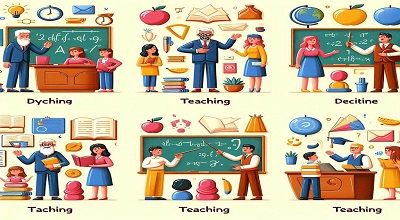Definition Of 5 Different Types Of Teaching
Different Types of Teaching is a dynamic and multifaceted profession encompassing various approaches and methodologies to facilitate learning. Different types of teaching methods cater to diverse learning styles, student needs, and educational objectives. In this discussion, we will explore five distinct types of teaching and their characteristics.
Traditional Teaching:
Traditional teaching is the conventional approach to education that has been widely used for centuries. It typically involves a teacher-centered classroom where the instructor imparts knowledge through lectures, textbooks, and direct instruction. This method relies on rote memorization and structured assessments. While traditional teaching provides a structured and organized learning environment, critics argue that it may not always engage students effectively or address individual learning preferences.
Collaborative Teaching:
Collaborative teaching, also known as cooperative learning, emphasizes group work and interaction among students. In this approach, the teacher serves as a facilitator, guiding students as they work together to achieve common learning goals. Collaborative teaching promotes teamwork, communication, and the development of interpersonal skills. It is particularly effective in fostering a sense of community within the classroom and preparing students for collaborative endeavors in the workforce. However, challenges may arise in managing group dynamics and ensuring equal participation from all students.
Inquiry-Based Teaching:
Inquiry-based teaching revolves around posing questions, problems, or scenarios that prompt students to explore, analyze, and discover information independently. Teachers act as guides, encouraging critical thinking, curiosity, and problem-solving skills. This approach emphasizes active engagement and encourages students to take ownership of their learning. By fostering a sense of inquiry, this teaching method helps develop a deeper understanding of the subject matter and enhances students’ ability to apply knowledge in real-world situations.
Technology-Enhanced Teaching:
As technology continues to advance, integrating digital tools and resources into the classroom has become increasingly popular. Technology-enhanced teaching leverages digital platforms, multimedia, and interactive resources to supplement traditional teaching methods. This approach aims to enhance engagement, cater to diverse learning styles, and provide access to a wealth of information. Teachers use tools such as interactive whiteboards, online simulations, and educational apps to create interactive and dynamic learning experiences. While technology can enhance the learning process, it also requires educators to stay updated on evolving technologies and adapt their teaching strategies accordingly.
Differentiated Teaching:
Differentiated teaching recognizes and accommodates the diverse learning needs of students within a single classroom. This approach involves tailoring instruction to match students’ readiness levels, interests, and learning profiles. Teachers may use a variety of instructional strategies, materials, and assessments to address individual needs, ensuring that each student has the opportunity to succeed. While differentiated teaching is effective in promoting inclusivity and accommodating diverse learning styles, it requires careful planning and resourcefulness on the part of educators.
Final Conclusion
In conclusion, the field of teaching encompasses a rich tapestry of approaches, each with its own strengths and limitations. Effective educators often integrate elements from multiple teaching types, adapting their methods to meet the unique needs of their students and the goals of the curriculum. By embracing a diverse range of teaching strategies, educators can create dynamic and engaging learning environments that foster academic growth and prepare students for success in an ever-evolving world.
